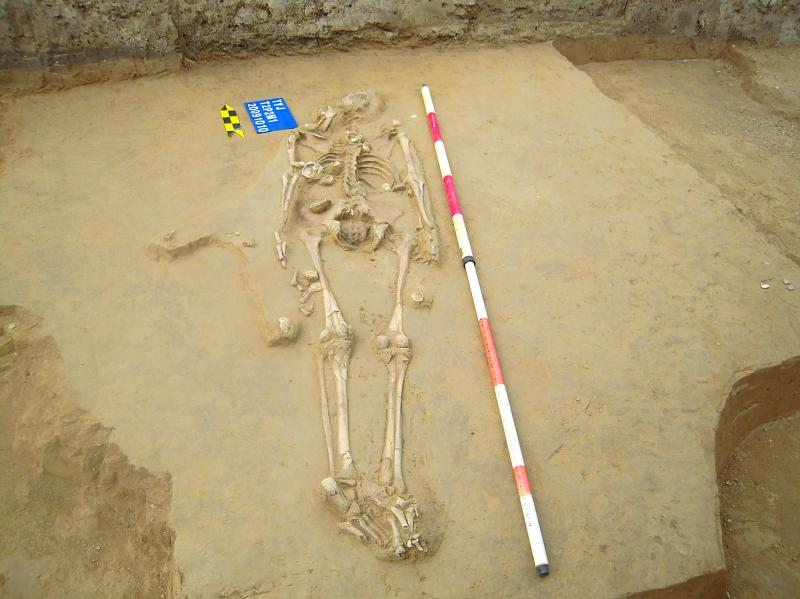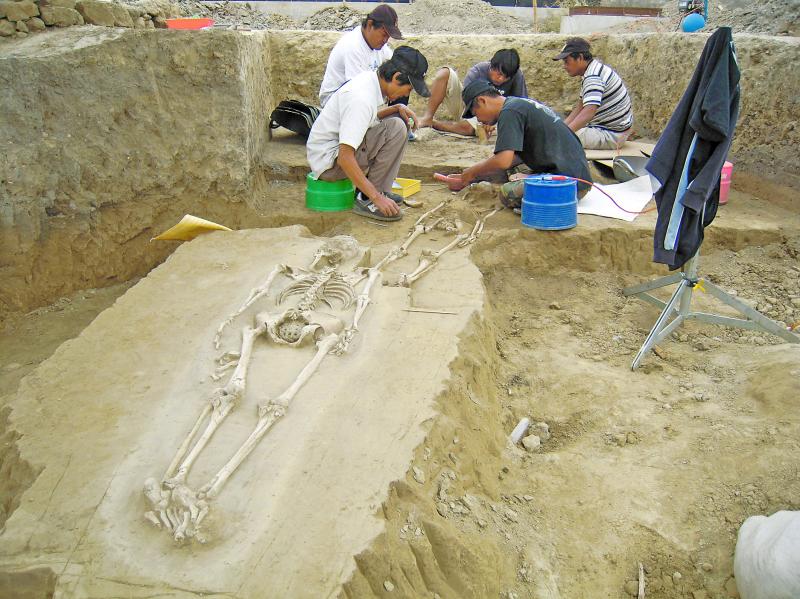Some of Taiwan’s prehistoric peoples buried their dead facing the sea, while others had their heads orientated towards the mountains. Some lay the dead on their backs looking skywards, others on their fronts, presumably staring eternally into the dark earth.
These different practices can no doubt tell us something about the views these ancient cultures held about life, death and the hereafter.
“Yes,” says Kuo Su-chiu (郭素秋), associate research fellow at Academia Sinica’s Institute of History and Philology, who has participated in numerous archaeological digs over the last three decades, “but what that is, is far from clear.

Photo courtesy of Kuo Su-chiu
“What is clear, is that each archaeological culture — many of which are ancestral to the twenty or more Aboriginal ethnicities of the modern era — had specific funeral customs that are as useful in identifying lines of inheritance and movements of people as are their potteries, stone tools and other material artifacts.”
She cites the example of the Shihsanhang (十 三行) site in New Taipei City’s Bali District, where beginning in 1990 around 300 skeletons were unearthed, dating from 1,800 to 600 years ago.
“All the skeletons were buried in a fetal position: on their sides with their limbs bent. Except one, an adult female, who was buried on her front and with her head turned to one side, which is typical of the contemporaneous Fantsuyuan (番仔園) Culture of central western Taiwan,” Kuo says.

Photo courtesy of Kuo Su-chiu
From this, Kuo surmises the woman possibly originated from 200km to the south and may have died shortly after her inter-tribal marriage, indicating positive interactions between the two peoples rather than, or in addition to, competition or warfare.
UNEARTHED
Three Fantsuyuan corpses unearthed in 2009 by Kuo’s team at the Caiyuanjiao (菜園角) site on the Changhua Plain all had their heads turned to face north-northeast, though whether this was to “view” the sunrise, a mountain of spiritual importance, a landmark to help spirits find their way home or some other reason, would only be speculation, she says. Similarly, skeletons facing out to sea might be keeping watch over fellow tribespeople while fishing or could be honoring the direction from which their ancestors arrived in Taiwan.

.Photo courtesy of Kuo Su-chiu
“It seems pretty clear that prehistoric peoples believed spirits inhabited the same space as the living, which is similar to the views of indigenous peoples in the modern era. Bad things could result from the bad moods of these spirits, so shamans performed ceremonies to interpret and placate them,” Kuo says.
Kuo adds that perhaps it is for this reason that corpses are buried close to homes at Caiyuanjiao, or sometimes actually inside the homes, such as in the Paiwan (排灣) Culture of southern Taiwan. In earlier times, she says, these latter were laid in a fetal position within a square slate coffin, but later on they were buried in a squatting position, with their heads just below the floor surface, so that they were as close as possible to tribespeople’s everyday activities.
The reason for this change is not known, but Kuo suggests it might be that, after repeated burials over several generations, they were simply running out of space. “Either way, it is clear they wished to keep their dead close to hand. Only people who died ‘unnaturally,’ such as by accident or suicide, were buried outside the community.”

Photo courtesy of Kuo Su-chiu
The Fantsuyuan did not use coffins and merely buried their dead within the middens of discarded clam shells, broken pottery and other kitchen waste, while their southern neighbors, the Favorlang (華武壟), did not even cover corpses with earth, according to notes for a 17th-century Dutch colonial ‘Favorlang Dictionary.’
Kuo found corroborating evidence on her digs indicating shallow pits had been dug but, since even closely arranged skeletons did not interfere with each other, it suggested that earlier placements must have been evident.
While most gravesites are empty as bones decay quite easily, occasionally skeletons are found almost intact, which can provide a wealth of details. In addition to identifying the height, age and gender, Kuo calls on specialists to interpret such things as injuries, nutritional deficiencies and cause of death, and even something as abstruse as which leg a person favored when squatting.

Photo courtesy of Kuo Su-chiu
“‘Empty’ is not the right word,” continues Kuo, “for while they might not contain bones which decay rapidly, graves may still contain funerary items buried with the dead. These can tell us a lot about the living, because the dead don’t bury themselves. And when objects are buried with them, they are taken out of circulation and no longer passed down to subsequent generations.”
TRADING NETWORKS
These funerary objects include glass, agate and shell beads, stone and metal tools, and local pottery as well as ceramics from China, Vietnam and Thailand, and bronze and silver coins from China, Japan and Mexico.

Photo courtesy of Kuo Su-chiu
As well as evidencing the vast networks of trade spanning firstly the South China Sea and later the globe, and helping to date individual sites, they also provide important data about economic conditions and social structures.
“Almost everyone buried at Shihsanhang, even the smallest child, was accompanied by funerary items. Some of these, like the human-figure nephrite earrings, would have been extremely valuable. This shows how rich the entire community was, due to their knowledge and practice of bloomery iron smelting.”
While pieces of iron have been found throughout Taiwan, they would have been obtained through trade, and Shihsanhang was one of only two communities in Taiwan which possessed the ability to smelt iron.
“In comparison, of the three skeletons at Caiyuanjiao, only one had three shell beads. These would have expressed the comparative wealth and status of the deceased,” says Kuo. “In southern Taiwan in the same period, men of the Niaosong (蔦松) Culture were often found buried with net sinkers and pointed bone or antler tools used for fishing and hunting, while many women were buried with spindle whorls used in weaving.”
“So although we still don’t know why some corpses are buried facing the ocean and others the mountains, whenever we excavate we learn something new about the ancient peoples and their ways of life,” concludes Kuo.

Exceptions to the rule are sometimes revealing. For a brief few years, there was an emerging ideological split between the Democratic Progressive Party (DPP) and Chinese Nationalist Party (KMT) that appeared to be pushing the DPP in a direction that would be considered more liberal, and the KMT more conservative. In the previous column, “The KMT-DPP’s bureaucrat-led developmental state” (Dec. 11, page 12), we examined how Taiwan’s democratic system developed, and how both the two main parties largely accepted a similar consensus on how Taiwan should be run domestically and did not split along the left-right lines more familiar in

As I finally slid into the warm embrace of the hot, clifftop pool, it was a serene moment of reflection. The sound of the river reflected off the cave walls, the white of our camping lights reflected off the dark, shimmering surface of the water, and I reflected on how fortunate I was to be here. After all, the beautiful walk through narrow canyons that had brought us here had been inaccessible for five years — and will be again soon. The day had started at the Huisun Forest Area (惠蓀林場), at the end of Nantou County Route 80, north and east

This month the government ordered a one-year block of Xiaohongshu (小紅書) or Rednote, a Chinese social media platform with more than 3 million users in Taiwan. The government pointed to widespread fraud activity on the platform, along with cybersecurity failures. Officials said that they had reached out to the company and asked it to change. However, they received no response. The pro-China parties, the Chinese Nationalist Party (KMT) and Taiwan People’s Party (TPP), immediately swung into action, denouncing the ban as an attack on free speech. This “free speech” claim was then echoed by the People’s Republic of China (PRC),

Specialty sandwiches loaded with the contents of an entire charcuterie board, overflowing with sauces, creams and all manner of creative add-ons, is perhaps one of the biggest global food trends of this year. From London to New York, lines form down the block for mortadella, burrata, pistachio and more stuffed between slices of fresh sourdough, rye or focaccia. To try the trend in Taipei, Munchies Mafia is for sure the spot — could this be the best sandwich in town? Carlos from Spain and Sergio from Mexico opened this spot just seven months ago. The two met working in the